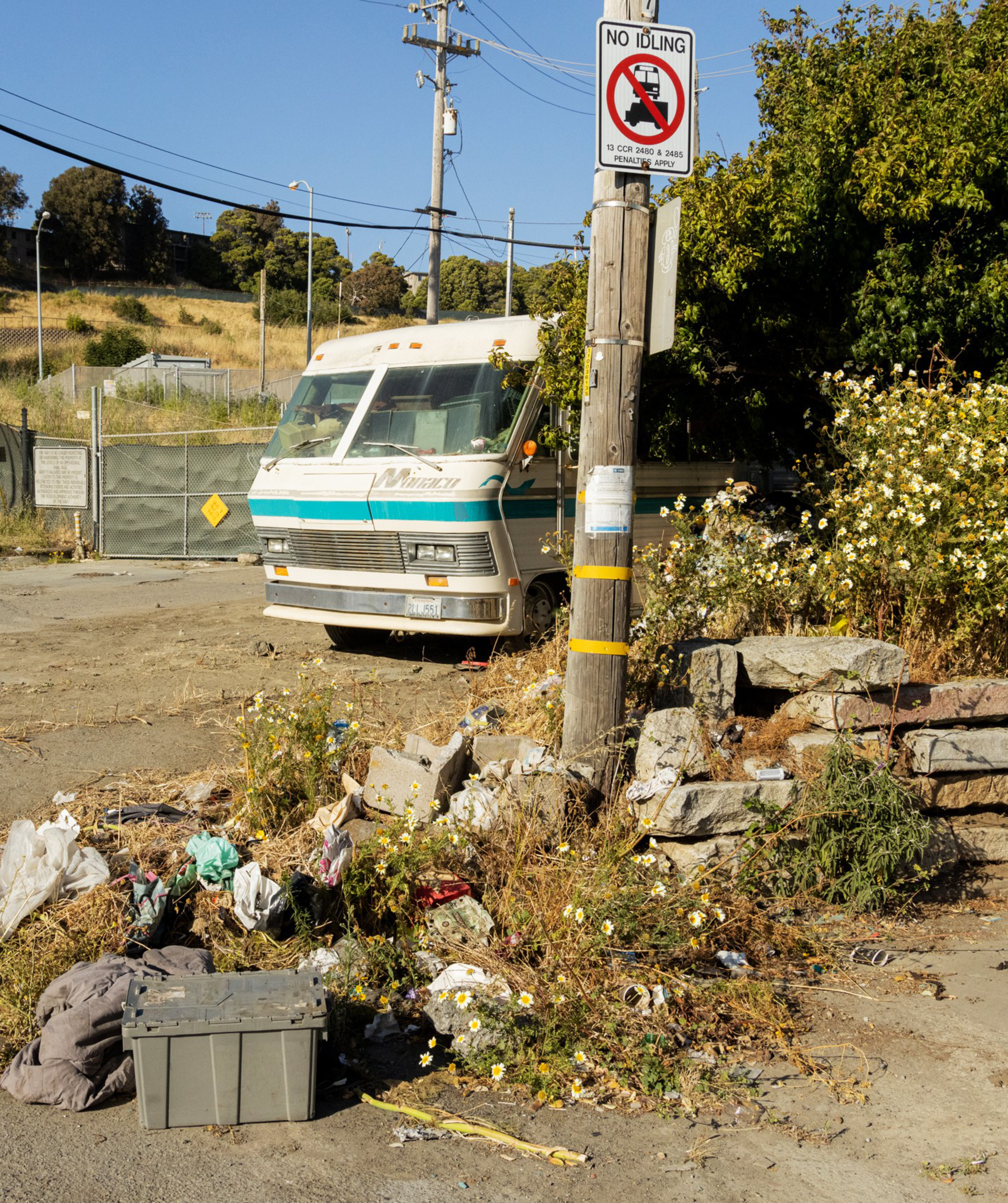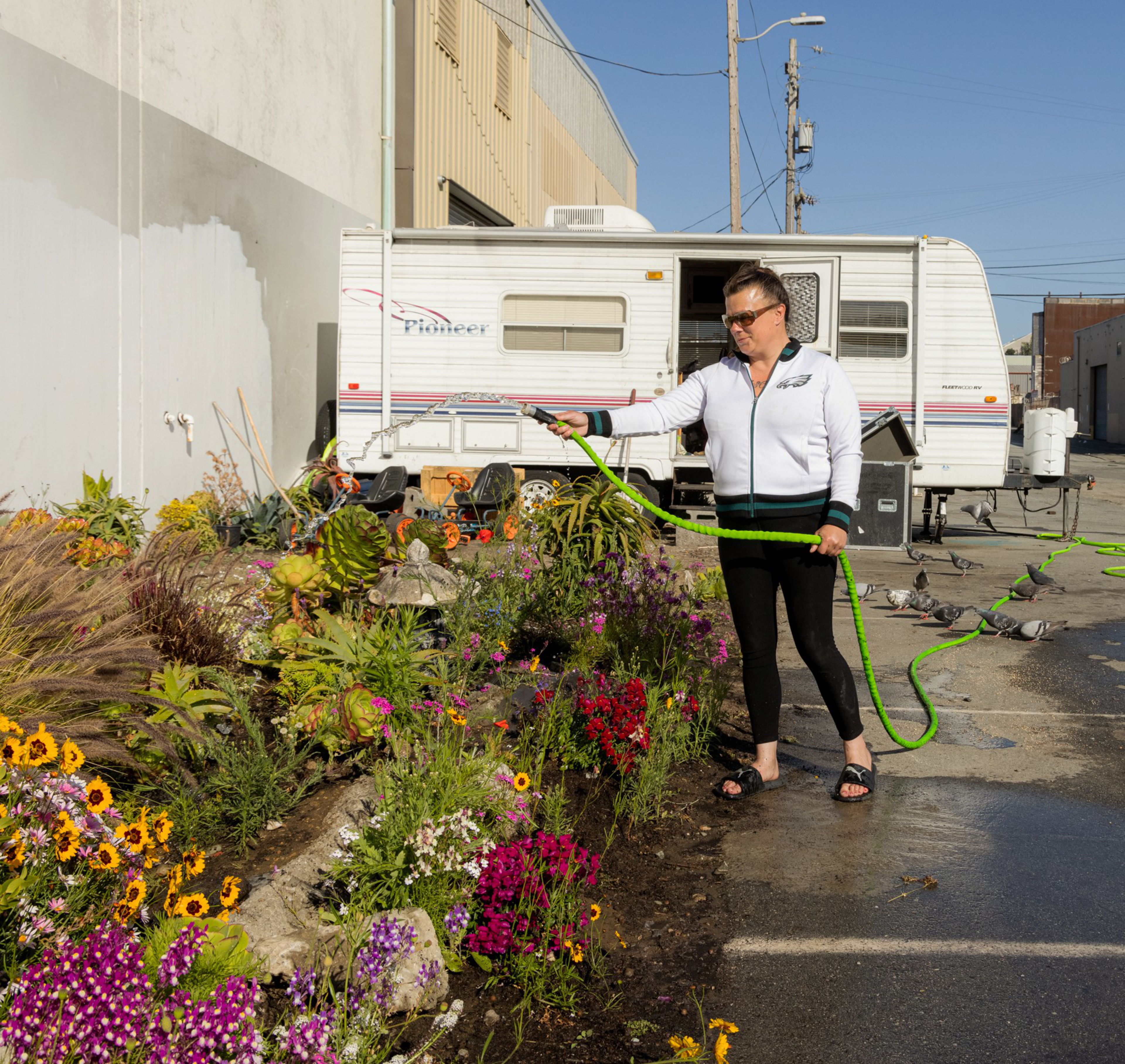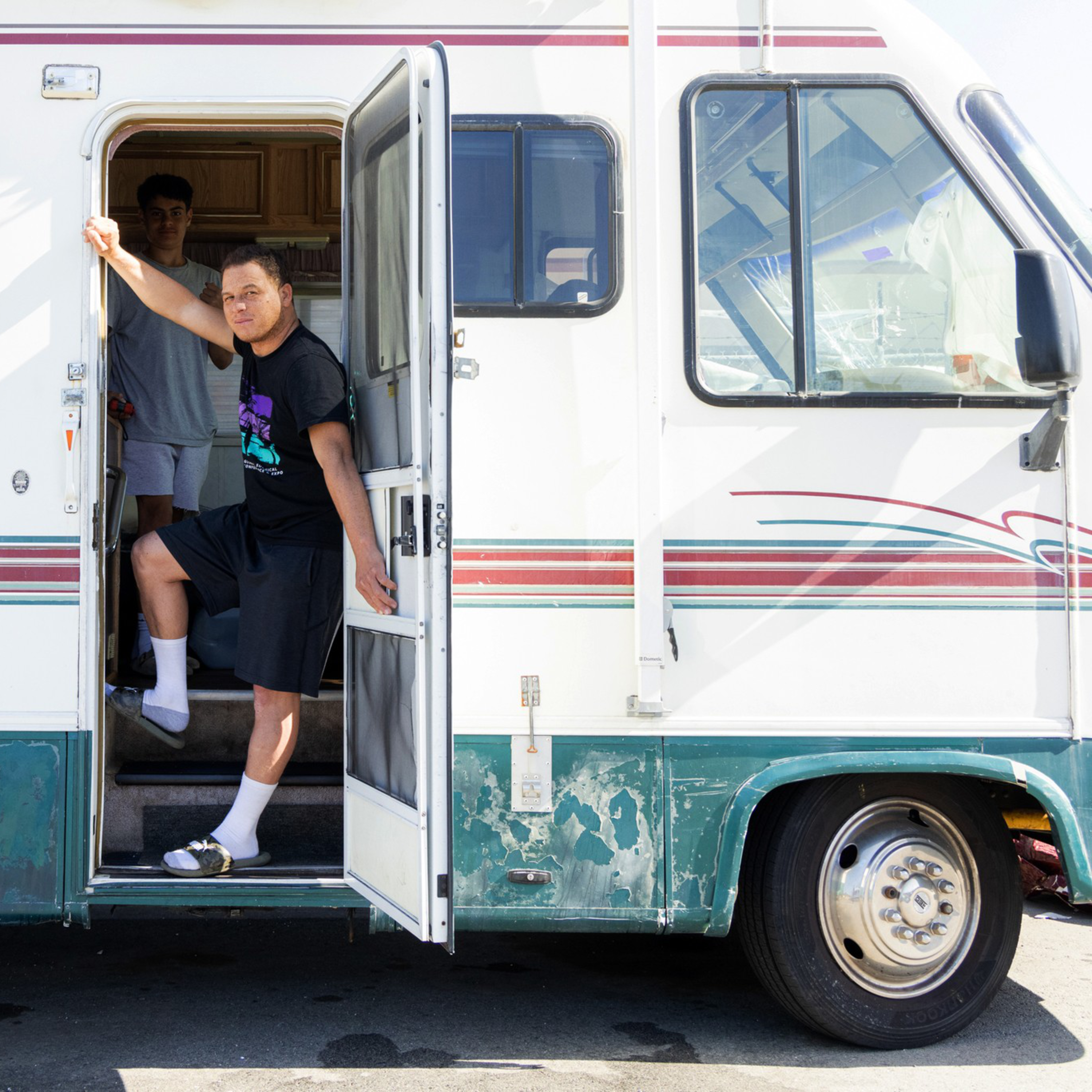Across San Francisco, about 1,400 people (opens in new tab) live in 700 cars, trailers and motorhomes (opens in new tab). Parked where there are few restrictions in the light industry section of Bayview-Hunters Point, the outskirts of the Design District and near the eastern shore of Lake Merced, these de facto residences are home to an estimated one-third of the city’s unsheltered population.
Most are working poor priced out of the Bay Area’s housing market or undocumented immigrants primarily from Central and South America. Some are reluctant commuters who live as far away as the deep Central Valley. Many are families with young children.
It’s a fragile existence, preferable to a life spent camping on sidewalks or bouncing around shelters, but in some ways just as tenuous. No one applauds this state of affairs or the dysfunction that brought it about. But there are some who profit from it, because some of the vehicles are not owned by their vulnerable inhabitants. They are rented month-to-month or sold lease-to-own at exorbitant prices.
The going rate is $500 to $2,000 per month depending on the age and condition of the vehicle along with the number of people packed in. The cost is less than the rent for a one-bedroom apartment, which averages $3,300, among the highest in the country. However, the vehicles are often dilapidated or inoperable, without insurance or current registration. In some areas, an underground economy keeps vehicles in working order with repair and utility services. And sharp business practices mean one missed rent or lease payment can result in eviction.
Interviews with homelessness professionals and experts, city officials and workers and the vehicular homeless, some of whom themselves rent and sell vehicles in the public right of way, reveal a shadow market for housing on four wheels, one that has drawn the attention of at least one lawmaker in San Francisco and more in other West Coast cities where the phenomenon is on the rise.


As neighbors complain and governments seek elusive solutions in a jumble of rules and regulations, vehicle dwellers find themselves at the mercy of police, parking control officers and profiteers alike. Losing a vehicle that’s been their shelter and even sometimes means of employment can put them on the streets.
The ‘vanlords’
On a dead-end street with a defunct printing press on one side and a delivery warehouse on the other, a dozen RVs and other ramshackle vehicles are parked. Near where the street runs into Caltrain tracks and K rails have been set up to prevent tent encampments, four men live in a 1997 Chevrolet motorhome.
On a recent morning, Emmanuel, 38, and Josephnell, 36, were getting ready for the day. That meant fetching basic necessities. They pay $2,500 per month for the RV. That doesn’t include water, power or sewage. “This is our livelihood. Rents are expensive here,” Emmanuel said before driving away to get more jugs of water.
The RV’s title is currently being transferred, DMV records show. The soon-to-be-registered-owner, Zildo Schineider, and his spouse have two ads on Facebook Marketplace for RV rentals. One stated it “is not necessary to pay a costly parking fee to rent it. This is not RV Parking, our tenants live on the street, we can indicate some streets where we have people living. You can park where you want to live!”
Court records show the couple took their former tenants, who lived in two RVs by TPC Harding Park, to small claims court in March over thousands of dollars in parking tickets, back rent and damage to the vehicle. One of the RVs is the same one Emmanuel and Josephnell live in with their roommates. The case was settled on Tuesday.

Schineider, who declined to speak about the court case, said he plans to stop renting RVs because it’s been a burden.
On another street a few miles away, a man in his 30s rented an RV to a family for several months. When they moved out, leaving San Francisco for a job opportunity in Southern California, he quickly took on new tenants. “They’re young and irresponsible,” said the RV owner, who spoke on the condition of anonymity on a recent Saturday afternoon.
His five tenants pay $600 a month since it’s an older model. But he added a $500 deposit after they moved in. “They crashed it and broke a door,” he said.
Of the dozens of recreational vehicles and trailers lining the two-block stretch, where he lives in a vehicle himself, he knew of six that were leased. “Some people charge $1,000 to $1,200,” he said. “It depends on how many people live in them.”
It can be cheaper than staying in the city’s one RV park, located by Candlestick Point State Recreation Area, which costs $2,000 per month but includes all the necessary amenities, namely water, power and waste hookups.
Some RV communities have pickup trucks outfitted with water tanks from which RV dwellers can draw. One even has a makeshift mobile waste dumping and water service. The going rate for sewage disposal is $50 and water is 50 cents a gallon.

Another longtime RV dweller, who spoke on the condition of anonymity, once bought and remodeled RVs to sell on something of a lease-to-own concept. When the leaseholder stopped paying, the vehicle reverted to the owner. “If you can’t pay it anymore then it’s like a rent and you just have to move,” he said. There’s no recourse for tenants since it’s done without records.
City workers not authorized to speak to the press said renting and leasing vehicles as housing has been going on for years. They usually discover it when addressing large encampments. One said tow yards sell old RVs and trailers at a price cheaper than the cost of destroying them. Portland, Seattle, Long Beach and Los Angeles are grappling with RVs used as housing on public streets. Some offer mobile waste removal (opens in new tab), sanitation and water-filling sites (opens in new tab) or disposal of vehicles in unlivable condition.
Depending on who you ask, the sale or lease of RVs and trailers to use as shelter on city streets is either a predatory or a humanitarian act. The city has had a depressingly low uptake on offers of housing when granted to RV dwellers. Many potential participants are reluctant to accept a housing subsidy voucher since staying in a vehicle can be more affordable in the long run.
“It’s a problem,” said Supervisor Myrna Melgar, whose Westside district includes about 120 vehicle dwellers concentrated around Lake Merced. In her district, a couple of RV tenants took housing vouchers from the homelessness department and then police seized the vehicles, she said.

Melgar is in the early stages of planning legislation to confront the issue of vehicles used for habitation on city streets. “It is imperative that we find a model to get people off of the public right of way and into places that are safe,” she said.
Los Angeles, facing the same housing and affordability issues as San Francisco, has attempted to crack down on so-called “vanlords” who sell and rent RVs on public streets but hasn’t yet determined the scope of their prevalence (opens in new tab). A new ordinance may require companies that rent and sell RVs to follow relevant state and federal laws including design and safety standards specified by the American National Standards Institute and the National Fire Protection Association or face escalating fines. One lawmaker (opens in new tab) even wants vanlords to pay relocation expenses for tenants.
While San Francisco doesn’t have any laws regulating vanlords specifically, the municipal police code does forbid leases, rental agreements or contracts of any kind for the use of any sidewalk or street enforceable by citations up to $300 per violation.
Curbside camping
San Francisco has over 1,000 miles of streets, and curbside campers have parked on them for decades. Usually contained to the coast and industrial areas on the south side, they have spread to residential areas in recent years as the numbers have grown, prompting an outcry from neighbors.
Marsha Maloof, a leader in the Bayview Hill Neighborhood Association for 25 years, said the rows of vehicles on Jennings and Ingalls streets have been troubling for years, with residents dumping waste on sidewalks and roadways. Members of her organization participate in committees dedicated to housing the vehicular homeless but finding a solution has been out of reach.

“It’s just awful that people must live this way because there isn’t enough housing,” Maloof said. “It’s a basic right. But we’ve had this conversation ad nauseam.”
People living in vehicles that don’t operate and have debris and waste around them get visited by the Healthy Streets Outreach Team and offered housing and services to try to move them inside.
In the face of complaints about RV-dwellers creating unsanitary conditions, monopolizing street parking and creating cover for drug dealing, lawmakers have periodically been moved to act.
A decade ago, supervisors implemented overnight and oversized vehicle parking restrictions (opens in new tab) on dozens of streets. Although the San Francisco Municipal Transportation Agency took time to study the parking changes (opens in new tab), examining the efficacy and the harm displacement causes, advocates for unhoused people blasted the restriction as criminalizing homelessness and eliminating an important path out of it. (This past March, a 27-year-old parking ban was rediscovered to clear people living in vehicles who had drawn the ire of residents in Bernal Heights.)
Jennifer Friedenbach, executive director of the Coalition on Homelessness, which has used the courts to challenge the often cruel status quo for enforcing laws applied to homeless people, said the people forced to live in RVs are just trying to survive and keep safe.

“Without that RV they would be on the streets and a lot less safe because at least with an RV, you have a door to lock,” she said. Friedenbach said that conversations about the issue of vehicular homelessness—such as renting and leasing vehicles as housing on city streets—are a distraction from the real issue: the dearth of affordable housing that’s driving up the number of vehicular homeless across the state.
In her many years of advocacy, Friedenbach said she’s personally heard RV dwellers complain about being evicted from rented RVs on city streets a couple of times. “I don’t understand why it’s a problem for poor people to rent cars, and it’s not a problem for rich people,” she said.
The coalition’s advocacy has changed the legal landscape around encampment clearing. In 2018, the organization challenged the state law allowing cities to tow vehicles with five or more unpaid parking violations in a given time frame. “Poverty tows,” named for the disparate impact they have on people who cannot afford to pay parking tickets, were ruled unconstitutional last summer.
The suit, in part, drove the transportation agency to develop programs offering discounts for people experiencing homelessness whose vehicles have been booted (opens in new tab) or towed (opens in new tab) along with citation waivers and late penalty dismissals. Since 2020, the SFMTA has granted 24,000 waivers totaling more than $16.5 million, records show.

Over the years, the coalition has asked the SFMTA to review and overhaul all of its overnight and oversized vehicle parking restrictions to develop a common-sense policy that spreads out the parking zones across the city. When vehicle dwellers become concentrated in one area, that prompts calls for more bans on overnight parking—and the city is reluctant to do that because it pushes the problem down the street.
Margot Kushel, a professor of medicine at UCSF and director of the UCSF Benioff Homelessness and Housing Initiative, not long ago completed a study of vehicular homelessness in Oakland (opens in new tab). Safe parking sites, shelters on private parking lots with hygiene infrastructure, are an attractive near-term solution. But they’ve been hard to come by in San Francisco due to space, cost and political will. “Housing is expensive, but managing homelessness is very expensive,” Kushel said.
For Josephnell, the RV dweller, a future place to go should they be forced to leave weighs on his mind. “We have moved several times and we don’t know what to do,” he said.

